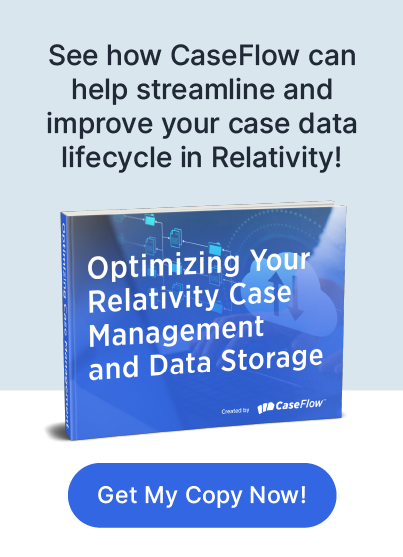How to Bypass the Agony of Manual Relativity Case Data Decisions

You sit down at your desk: You’ve got 237 active Relativity workspaces sitting in front of you, and that’s not even counting the archived ones. Some of these cases haven’t been touched in months. A few might be active, and a bunch were probably closed ages ago, but you’re not entirely sure because nobody ever seems to confirm anything. Now someone from finance is asking if you can free up storage to cut costs—again.
That’s what it feels like to manage data in most firms. You’ve got mountains of workspaces, unreliable tracking, and no easy way to know who’s still using what or whether you can safely archive it without triggering a panic call from an attorney two weeks later.
But here’s the bigger issue: Every time you hesitate because you aren’t 100% sure, you’re not just wasting time; you’re also wasting money. That uncertainty leads directly to excess storage fees, compliance risk, and massive operational drag.
The truth is simply that the root problem isn’t the storage or the size of your firm. It’s that most case data decisions still rely on manual processes that simply don’t scale.
Why Manual Case Data Decisions Drain Time and Resources
Let’s not pretend this is new. Legal teams have been wrestling with this problem for years. Every time you need to figure out what’s happening with a workspace, it’s basically a mini project.
First, you start digging into reports. You may be able to pull last access dates, storage usage, user activity, and possibly even billing data from your cloud provider. That might give you a vague sense of whether anyone's touched the data recently, but it’s rarely enough to actually make a confident decision.
So, you move on to step two, which is asking people. You start sending messages to attorneys:
- “Hey, is the ABC Corp litigation matter still active?”
- “Do we still need workspace 2019_ProductLiability?”
Sometimes you get responses right away. Sometimes, you wait a week, and the answer is: “I think so, but let me check with opposing counsel.” Other times, you get three different answers depending on whom you ask.
Even after you get a few responses, you still have to cross-check those against your internal status logs, assuming those are even up to date (and if you’re dealing with spreadsheets, they probably aren’t).
That’s the daily grind—dig through reports, ask attorneys, update spreadsheets, repeat.
While you're doing all of that, your storage bill just keeps growing, and the problem compounds fast:
- Missed archiving windows mean you keep paying for data that could have been safely retired.
- You burn hours of high-value staff time just trying to confirm simple workspace statuses.
- Attorneys lose patience with the endless status check-ins.
Worst of all, you increase your firm’s risk exposure by holding onto unnecessary data longer than necessary. It’s not just a nuisance; it’s an operational cost that gets more painful as you scale.
The Limits of Existing Workarounds
Of course, most teams don’t sit still and do nothing. They build their own internal workarounds to try to stay ahead of the problem.
The Tracker Spreadsheet
The most common tool is the infamous tracker spreadsheet. You know the one: It lists every workspace by name, client, lead attorney, size, and last access date and perhaps has a few notes about case status. In theory, this is your master list, the single source of truth for your Relativity case data. In practice, it’s almost never current.
Attorneys forget to report changes. Paralegals mark a workspace as active when it’s not. Somebody didn’t log an archive date. Worst of all is when two people try to update the spreadsheet at the same time without proper version control.
Spreadsheets work—until they don’t. They simply can’t keep up as your caseload grows.
The Email Chains and Status Meetings
Then you’ve got the email chains. Someone sends a monthly “workspace status update” email to the litigation group. A few people respond and a few don’t. You chase down the latter.
Some firms try to supplement that with standing status meetings. But now you’ve got your senior legal staff sitting in meetings every month, talking about which workspaces might be inactive, and you still end up making half the decisions based on gut instinct rather than actual data.
At best, these manual workarounds delay decisions. At worst, they allow bad decisions—or no decisions—to be made.
Manual data management simply doesn’t scale.
Why the Problem Grows as Your Firm Grows
The thing that catches many firms off guard is how quickly this problem accelerates. When you’re managing fifty or 100 active Matters, you might be able to stay reasonably organized with a few spreadsheets and email chains.
But once you start managing 500 or 1,000 Matters, the cracks show fast. Your litigation support team gets overloaded with status requests, attorneys stop responding to your emails because they’ve answered the same question five times already, your cloud storage bill balloons as inactive workspaces sit idle for years, and compliance teams get nervous because data retention policies aren’t being followed consistently.
At this point, the data management process isn’t just inefficient. It’s also actively working against your firm’s profitability and risk management efforts.
The Smarter Alternative: Automated Case Data Monitoring
There’s a better way to do this, and it doesn’t involve hiring more staff or running bigger spreadsheets. Instead of manually tracking workspaces and constantly asking attorneys for updates, you let automation do the heavy lifting.
This is where platforms like CaseFlow come in.
With automated data monitoring, you shift from guesswork to real-time visibility. The system continuously monitors every workspace inside Relativity for usage patterns, last access, storage consumption, and user activity. You know exactly when a workspace hasn’t been touched for ninety, 180, or 365 days, you see which attorneys last accessed the case, and you get alerts for cases that meet your firm’s archiving criteria.
There’s no more pulling outdated reports, no more status meetings, and no more chasing attorneys for input. Your litigation support and legal operations teams have a clear, data-backed foundation for making decisions, without all the manual back-and-forth.
Perhaps most importantly, the entire process is fully auditable. You generate clear audit trails for every archive decision made, which helps satisfy client data retention policies, GDPR and CCPA obligations, and any internal compliance standards.
Automation Preserves Attorney Time
One of the benefits that law firms often overlook is the amount of attorney time this frees up. When your litigation team no longer has to constantly respond to workspace status requests, they stay focused on client work. That’s billable time that you get back, and it’s a major morale boost for partners who grow tired of endless operational interruptions.
Attorneys still stay involved when needed, but they’re no longer the bottleneck for every workspace decision.
A Real-World Payoff
Let’s put real numbers to this: A mid-sized litigation firm managing 800 workspaces might spend an average of twenty minutes per workspace each year chasing status updates, pulling reports, reconciling spreadsheets, and updating archive plans. That totals over 266 hours a year just to manually maintain data.
At an average internal cost of $100 per hour (factoring in attorney, paralegal, and litigation support salaries), that’s $26,000 a year wasted on process overhead alone, not counting storage overspend or compliance risk.
Automation cuts that dramatically. With real-time monitoring, you can safely retire dozens or hundreds of inactive workspaces sooner, reduce cloud costs, free up internal resources, and lower your firm’s risk exposure, all while reducing attorney friction.
Stop Guessing and Start Acting
Manual case data management worked ten years ago, but it doesn’t work now. Your firm doesn’t need bigger spreadsheets or more status meetings. You need actual visibility.
By shifting to automated monitoring platforms like CaseFlow, you can finally stop treating Relativity workspace decisions like a guessing game.
Instead, you’ll have clear data, immediate insight, faster decisions, lower storage costs, happier attorneys, and a litigation support team that can finally get ahead of the problem instead of constantly reacting to it.
Ready to take control of your Relativity data lifecycle and eliminate unnecessary costs and wasted time? CaseFlow provides the automation that you need to proactively manage your Relativity storage, seamlessly transitioning cases through Repository, Cold Storage, and Archive based on your specific requirements. Don't let manual processes bog you down; see how CaseFlow can save your law firm time and money. Contact us today, and discover the power of automated Relativity data lifecycle management.



